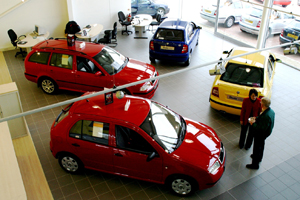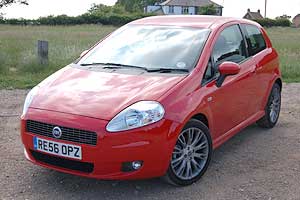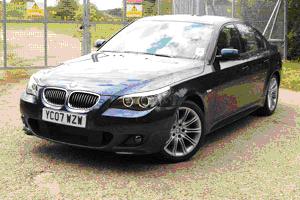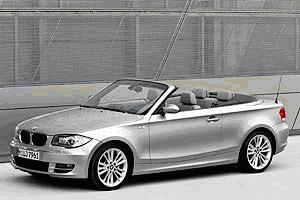January 2009
Monthly Archive
January 28, 2009
Toyota is to recall more than 45,000 cars to fix the seat belt defect. The car owners of Toyota Yaris 2006 and 2007 models will receive letters informing them about the fault.
Toyota spokesperson reported that the seat belt pre-tensioner which is the safety measure that locks the seat belt in place during a collision, could heat up and cause a fire in high speed-on crash.
One case of fire was reported in Japan due to the faulty seatbelt design, which could cause a noise-absorber device to melt when the seatbelt tensioner is activated in a collision, Toyota said. There have not been any reported cases of accident due to this happening.
He said: “We can use chassis numbers to identify the cars involved and then trace the owners through the DVLA to ensure the right people are sent letters.”
A total of 1.3 million vehicles are being recalled worldwide.
January 26, 2009
Hyundai has released details of its last year’s performance indicating rise in 2008 sales. The sales revenue rose 5.1% to 32.19 trillion won helped by a richer product mix and the sharp depreciation of the Korean won against major currencies.
However, the Profitability of Hyundai declined by 13.9% to 1.448 trillion won from a year earlier.Operating profit dropped by 3.5% to 1.877 trillion won due to higher marketing, dealer and brand development expenses.
“The rate of decline was abated by widely implemented cost-cutting efforts and continuous efforts to diversify the settlement currency. By prudently diversifying its global sales footprint, the company isn’t overly affected by the economic volatility of any one region,” a statement said.
It added that it expected sales momentum to continue to build with the launch of the i20. Used car market and motor industry analysts CAP say the i20 will retain a greater percentage of its original value after three years than a plethora of highly-regarded rivals. This includes those renowned for holding their value such as the VW Polo and Toyota Yaris, as well as big players like the Vauxhall Corsa, Peugeot 207 and even the new Ford Fiesta. The newly launched i10 and i30 were well received.
In China, Hyundai registered 27.1% growth in sales, whereas in eastern Europe, the Middle East, Latin America and other developing markets, Hyundai registered 19.5% growth.
Source: Just Auto
January 26, 2009

Car Reviews
Few basic things to know about THAT car you are buying…
- What’s your Budget?
- What features are you looking for?
- What Type of car?
- Eco-friendly – how much CO2 emitted?
Let’s look at the above factors one by one.
Budget – It’s very important to decide on your budget first. With so many popular car manufacturers competing, it might be difficult to eliminate the options. So, it important to know how much you would be willing to spend to buy a worthy car.
Features – Choose wisely and figure out what features are more important and does your car match them –
- Passenger capacity: Most of the vehicles have the capacity to seat five individuals. It would be ideal for a small family or small group of friends. If you have a larger family then its worth considering a seven or eight seater MPV. Single & sporty motorists usually go for two or four seater cars.
- Size: Depending on the passenger capacity and luggage room you can decide upon the size of your car. It’s good to ask yourself how much of Boot utilization would you require. If you have bulky equipments to carry think of going for a family hatchback with a roof rack.
- Appearance: This is the first thing that comes into mind when you decide to buy a car. The appearance of the car is what others will see – so be careful. Would you go for something bright or dark, curvy or less curvy, small or long or sleek? Consider extras like metallic paint, modified body kits etc. The interior look and feel of the car is another vital thing to think of.
- Safety: Sometimes this feature is neglected – but this in fact is the first factor to be taken into consideration. Ensure the number of airbags it has and always check the Euro NCAP’s star rating for each car before you buy.
- Performance: If you are a frequent motorways user then an acceleration time between 0 to 60mph may be crucial. Also would be the brake horse power. Evaluate your engine size depending on your insurance budget. Higher the performance, higher is the engine cost.
Type of car – Yet another important fact you ought to know. Is it Hatchback, Supermini or Sports?
Type of Cars in detail
Eco-friendly – The more the CO2 the car emits, higher is the car tax. So, make sure you calculate how many miles to the gallon your car burns. If you are looking for an eco-friendly vehicle you may choose electric, bioethanol or hybrid cars.
Six of the best Tax – Free cars.
January 23, 2009
Yet another bad news for the Automotive Industry; 2009 beginning does’t look colourful, with the number of cars being licensed dropping down. The statistics agency has confirmed 19% drop in new cars being licensed compared to the previous year. There were about 146,500 new cars licensed in 2009. The number of cars licensed in December 2008 is half the number in December 2007.
Source: Belfast Telegraph
January 23, 2009
As per the new government crackdown announced on 20th Jan 09, two million uninsured drivers have to let go their vehicles. So now if you own an illegal vehicle it is considered to be illegal.
The percentage of uninsured drivers is anticipated to be 6.5. The law passed is definately in the favour of the majority since the uninsured drivers tend to push up the premium for others by £30 a year. Moreover, records reveal that uninsured drivers that could not be traced were responsible for crashes that injured 23,000 every year.
More than 400 cars are seized every day and there is a fine of £100 that applies for non-compliance. So its become a necessity for car owners to get insured.
Source: News.Scotsman.com
Need help choosing the right car insurance policy?
If you are looking to compare quotes, don’t miss this this quick and easy Insurance Comparison tool.
January 23, 2009
The news of German car maker Audi planning to lay off 1,400-1,600 staff at its Gyor plant was actually a rumour. This was clarified by the Audi hungaria spokesman; Peter lore. Peter told Reuters, “This report is not true, I deny it”.
Audi TT, TT Roadster and Audi A3 convertible are produced in the Hungary plant. Audi said in November it would halt car production for four weeks from mid-December and engine production would also stop for 2-4 weeks, depending on the type of the engine.
The Audi hungarian plant produced 1.9 million engines and assembled more than 60,000 vehicles last year.
Source: Reuters
World debut for fastest Audi R8 ever
January 22, 2009
As the crisis facing the world’s Automotive Industry deepens, last few months has seen an increasing rise in car tax and new and used car prices. What next for car buyers? Some helpful tips you need to know before buying used or new cars in 2009.
The road tax prices are set to rise by £5 on April 1, for cars registered after March 2001 and are expected to rise for vehicles registered from April 2010. The petrol price is expected to rise as the crisis continues in the first half of 2009. With this the obvious question arises, when would be the right time to buy? On the contrary, this time can be supposedly green for many car dealers trying to sell used and new cars. It can turn out to be a sweet season for car buying bargains with many car dealers subsidising on the used and new car rates. Motorists have seen plenty of offers in the past few months, including half-price cars, buy one get one free deals and VAT-free cars.
Interesting to know, which would be the cars featuring 2009? Some massive UK car releases for this year include Volkswagen Golf, Ford KA, Nissan GT-R, Aston Martin One-77, Ford Focus RS. Whereas the ones already in demand are Toyota Corolla, Nissan Altima, Audi A4. Amongst the Sports cars, the ones on top include Ford Shelby GT500, Ford Mustang, BMW 1 series and Chevrolet Camarao. The value for money car goes to Mercedes Benz C Class. There is an anticipation of more green and eco-friendly cars being launched in the coming years.
On the Insurance front, some things worthwhile considering are how to get best deals on car insurance and pay minimum premiums. If its a low value car, you can choose third party cover. Its worth trying the insurance comparison tool to get an instant quote from over variety of car insurance sellers. You might build up your no claims bonus – accident-free motorists can receive discounts of up to 70 per cent. Most importantly; avoid modifying your car.
Buying a car is the biggest investment you’ll make, so it pays to make sure your purchase is as safe as possible. Beware of whole range of scams such as false escrow services and clocking, so you can stay safe with when buying a car.
View the UK’s cheapest cars to insure
January 20, 2009

Fiat Punto
With its increased size, the Grande Fiat Punto has increased its good looks, character and fun factor. In fact the only thing not to grow huge is its price.
The Grande Fiat Punto is surely the prettiest supermini on the road. Its front is reminiscent of the Aston Martin DB7, which can only be a good thing, while the rear and sides carry on the curvy theme.
So often interiors fail to live up to the expectations set by the bodywork. Not so with the Grande Punto.
As the Grande Punto has grown since its predecessor, so has its levels of practicality. There’s lots of room in the front, and all but the tallest of rear passengers can fit in the back fairly easily.
The Grande Punto feels sure-footed and composed at speed, which has a lot to do with the extra width of the larger car.
Fiat is renowned for its diesel engines, and the 130bhp 1.9 Multijet fitted to our test car is a gem. It feels punchy, refined and loves to rev, unlike most diesels which run out of puff around 3,000rpm.
Scoring a full five star rating in the EuroNCAP crash test programme is commonplace, so its no surprise the Grande Punto has followed suit.
The Grande Fiat Punto oozes style from every angle. It’s great fun to drive, especially in the 1.9 Sporting guise. But best of all is its tremendous value for money.
January 19, 2009

BMW 5 Series
The BMW 5 Series is the standard which all other large executive saloon cars are judged. It has managed to blend comfort with the kind of driving dynamics which shame some so-called sportscars.
There’s no doubting the presence the 5 Series offers – it still looks striking long after its 2003 launch. But the radical appearance has put some buyers off, opting for more conservative styling from Audi and Mercedes.
This generation of Five was the first to shun the dashboard layout which almost wraps around the driver. In fact, it does the opposite, with it bowing out in the centre of the car and sweeping back on either side.
The 5 Series handles better than any large saloon car has the right to. Its front engine/rear wheel drive layout improves weight distribution and with the power being sent rearwards.
Its £36,000 price tag puts the 530d we tested up against some serious opposition, but few offer the driving thrills the big BMW can.
All 5 Series come well appointed, with the iDrive system controlling the stereo, CD player, air-con and traction control. Steering wheel-mounted audio controls and electric seats are also standard.
The 5 Series has been the benchmark for a quality executive express for many years, and the latest model does plenty to keep it ahead of the pack.
January 19, 2009

BMW Convertible
BMW is offering drivers drop-top thrills with lower bills – the BMW 1 Series Convertible is now being offered with two diesel engines, adding the BMW 118d Convertible and BMW 123d Convertible to the range.
The BMW 1 Series Convertible – which launched last October – now features a 2-litre turbocharged diesel engine (badged 118d Convertible) churning out 143bhp and 221lb/ft of pulling power, while returning 57.6mpg on the combined cycle.
This BMW 123d Convertible is capable of returning 52.3mpg on the combined cycle – more than a 1.5-litre Mazda 2 supermini – and emits 144g/km of CO2, meaning an annual road tax bill of £120.
Next Page »



